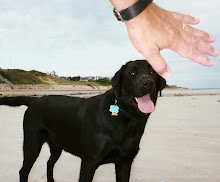
Why? Because amidst all the chaos, two amazing things happened: You learned to focus on your work despite the din and you fed off the creative energy of your colleagues.
I was reminded of this by a visit this week to the offices of Google in Cambridge and the stark contrast that workplace has to my current digs.
Goggle (where my son is doing a summer internship for math and computer whiz kids) promotes a very open office culture. Work spaces for nearly all 350 employees are open-air cubicles, spread out over three or four floors of their building. Even the boss has a cubicle (though he also has exclusive dibs on a small conference room for private meetings). There's stuff everywhere – from hanging mobiles to dog beds, large robots to a life-size cutout of John Kerry (no, those aren’t the same thing!). There’s a geodesic dome the size of a two-person tent – and there's an actual tent and sleeping bag. There are several well-stocked, free-for-all kitchens, a sound-proof workout/rumpus room, a game room (ping pong, foosball, etc.), and lots more.

Googlers gather for meetings around their desks or in "huddle rooms" -- meeting spaces stocked with computers and video conferencing equipment that are often decorated with toys or props around a particular theme. And there are whiteboards everywhere that are covered by undecipherable writing and calculations. Apparently between the Nerf gun duels and flying remote-controlled dirigible contests, a lot of work gets done. Mid day, the boss said, it can be remarkably quiet, in fact.
Where I work now is a bit more traditional – very nice, orderly, and quiet. Almost everyone has a private office. And while most doors remain open, people tend to sit at their desks and do their work in solitude. Collaboration happens among members of 2-3-person teams or at all-staff meetings. Most of these come with prepared agendas.
Don't get me wrong; it's a great group of people, and they tend to work hard and well. But we’re not operating in an environment that's conducive to free-flowing thinking and spontaneous collaboration. In fact, that's one of our main organizational conundrums – how to break out of the silo frame of mind where I do my work and you do yours without regard for how our actions and goals might intersect. Our management team has begun to make progress on getting people to think beyond their old bounds, but it is a challenge.
In the old newsroom, things hummed along on adrenalin, coffee, and other creative juices. Your business was everybody else’s. Everyone worked toward a common goal. It seems that same thing happens at Google. I’m sure it’s not just the no-walls approach (or the toys), but it sure shows what a bit of out-of-the-box (or -office) thinking can produce.

.jpg)